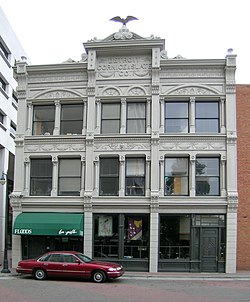
The Detroit Metro Times is a progressive alternative weekly located in Detroit, Michigan. It is the largest circulating weekly newspaper in the metro Detroit area.

Ally Detroit Center, formerly One Detroit Center, is a skyscraper and class-A office building located in Downtown Detroit, overlooking the Detroit Financial District. Rising 619 feet (189 m), the 43-story tower is the tallest office building in Michigan and the second tallest building overall in the state behind the central hotel tower of the Renaissance Center, located a few blocks away. Although the Penobscot Building has more floors above ground (45), those of Ally Detroit Center are taller, with its roof sitting roughly 60 feet (18 m) taller than that of the Penobscot. It has a floor area of 1,674,708 sq ft (155,585.5 m2).
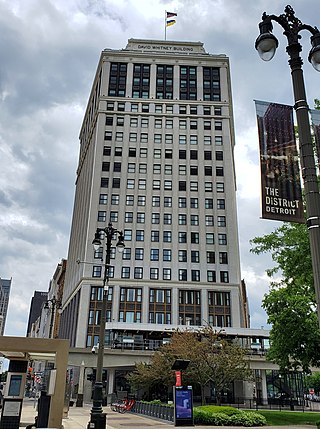
The David Whitney Building is a historic class-A skyscraper located at 1 Park Avenue, on the northern edge of Downtown Detroit, Michigan, within the Grand Circus Park Historic District. The building stands on a wedge-shaped site at the junction of Park Avenue, Woodward Avenue, and Washington Boulevard. Construction on the 19-floor structure began in 1914.

The Broderick Tower is a residential skyscraper in Downtown Detroit, Michigan. Original construction began in 1926, and was completed in 1928. The Broderick was fully renovated in 2012 by JC Beal Construction Inc., who also served as the developer. The tower was the second tallest building in Michigan when it was originally completed in 1928. It stands 34-stories, with two basement floors. The building is designed with Neo-classical architecture, Chicago school, and Beaux-Arts designs. Limestone is a prominent material in the building's surface. It was designed by architects Louis Kamper and Paul Kamper for Theodore Eaton.

The Detroit Free Press Building is an office building designed by Albert Kahn Associates in downtown Detroit, Michigan. Construction began in 1924 and was completed in 1925.

The First National Building is a skyscraper and class-A office center in Downtown Detroit, Michigan, within the Detroit Financial District. The building is located across the streets from Cadillac Tower and One Detroit Center, and stands next to the Vinton Building.

Chrysler House is a 23-story, 325-foot (99 m) skyscraper located at 719 Griswold Street in Downtown Detroit, Michigan. The building is adjacent to the Penobscot Building in the heart of the U.S. designated Detroit Financial District. It is used as an office building, with retail space on the street level. It was originally known as the Dime Building but has carried numerous names over the years.

The Penobscot Building is the original 13-story building of the Penobscot Block complex in downtown Detroit, Michigan. It is the first Penobscot Building, and one of three buildings of the same name in the later-constructed complex. It is located at 131 West Fort Street, within the Detroit Financial District.
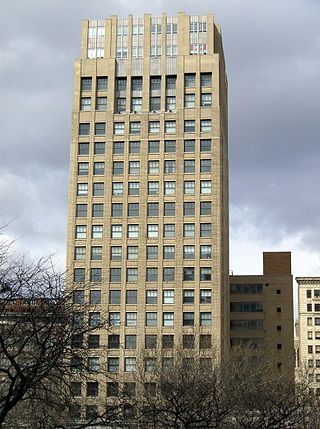
Grand Park Centre, also known as the Michigan Mutual Building, is a high-rise office building in downtown Detroit, Michigan, located at 28 West Adams Avenue, at the corner of Adams Avenue West and Woodward Avenue, standing across from Grand Circus Park in the Foxtown neighbourhood. Nearby buildings and attractions are Grand Circus Park, Comerica Park, Ford Field, the Dime Building, and Campus Martius Park. The building is a part of the Michigan Mutual Liability Company Complex, with the Michigan Mutual Liability Annex. The building is located in the Foxtown neighborhood of Detroit.

The Wayne County Building is a monumental government structure located at 600 Randolph Street in Downtown Detroit, Michigan. It formerly contained the Wayne County administrative offices – now located in the Guardian Building at 500 Griswold Street – and its courthouse. As Wayne County Courthouse, it was listed on the National Register of Historic Places in 1975. When it was completed in 1902, it was regarded as "one of the most sumptuous buildings in Michigan".

The Vinton Building is a residential high-rise located at 600 Woodward Avenue in Downtown Detroit, Michigan. It stands next to the First National Building, across Woodward Avenue from Chase Tower and the Guardian Building, and across Congress Street from One Detroit Center. It was designated a Michigan State Historic Site in 1982 and listed on the National Register of Historic Places in 1983.

The Blue Cross Blue Shield of Michigan Building is a skyscraper located at 600 East Lafayette Boulevard in Downtown Detroit, Michigan, near the Renaissance Center complex. It is also known as the Blue Cross Blue Shield Service Center. It was constructed in 1971, and stands at 22 floors. The building was constructed in a sunken plaza. It houses Blue Cross Blue Shield of Michigan. The campus in downtown Detroit also includes offices for 3,000 employees at Towers 500 and 600 of the Renaissance Center linked by the Detroit People Mover.

The architecture of metropolitan Detroit continues to attract the attention of architects and preservationists alike. With one of the world's recognizable skylines, Detroit's waterfront panorama shows a variety of architectural styles. The post-modern neogothic spires of One Detroit Center refer to designs of the city's historic Art Deco skyscrapers. Together with the Renaissance Center, they form the city's distinctive skyline.

The Industrial Building is a high-rise building located at 1410 Washington Boulevard in downtown Detroit, Michigan, within the Washington Boulevard Historic District. It occupies the northeast corner on Grand River Avenue and Washington Boulevard.

The Bonstelle Theatre is a theater and former synagogue owned by Wayne State University, located at 3424 Woodward Avenue in the Midtown Woodward Historic District of Detroit, Michigan. It was built in 1902 as the Temple Beth-El, and was listed on the National Register of Historic Places in 1982. As of 2023, the Bonstelle is planned to be renovated and integrated into a newly-constructed hotel.

The Third Precinct Police Station is a former police station located at 2200 Hunt Street in Detroit, Michigan. The building was listed on the National Register of Historic Places in 1980. It now holds a co-working space, known as "Hunt Street Station."
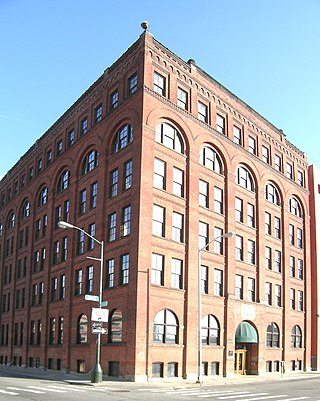
The Globe Tobacco Building is a manufacturing building located at 407 East Fort Street in Downtown Detroit, Michigan. It is the oldest tobacco manufactory extant in Detroit, and is listed by the National Register of Historic Places.

The Detroit Financial District is a United States historic district in downtown Detroit, Michigan. The district was listed on the U.S. National Register of Historic Places on December 14, 2009, and was announced as the featured listing in the National Park Service's weekly list of December 24, 2009.
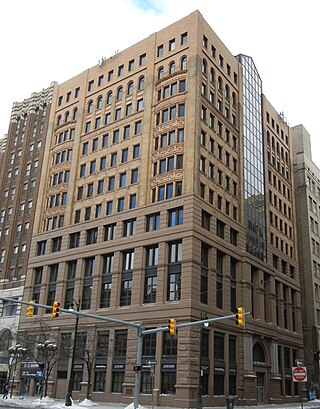
The United Way Community Services Building is a high-rise office building completed in 1895 at 1212 Griswold Street, at the northeast corner of State Street, in the Capitol Park Historic District of downtown Detroit, Michigan. The 48.77 m (160.0 ft) 12-story building was designed by architects Spier & Rohns and was the tallest in the state when built. The lower two floors are faced with a brown rusticated stone with the main entry centered on the south façade and framed by four square pilasters of gray granite. Floors three through five are smooth stone and floors six through twelve are tan brick. The structure originally had an elaborate cornice surrounding the twelfth floor which was removed in the 1950s. The light court which extended from the fifth to twelfth floor above the entry was filled in 1988 and faced with glass and a gabled glass roof to provide additional office space.

Affirmations is a Michigan nonprofit community center serving the lesbian, gay, bisexual and transgender (LGBTQ) population of Ferndale, Michigan, and nearby communities.
